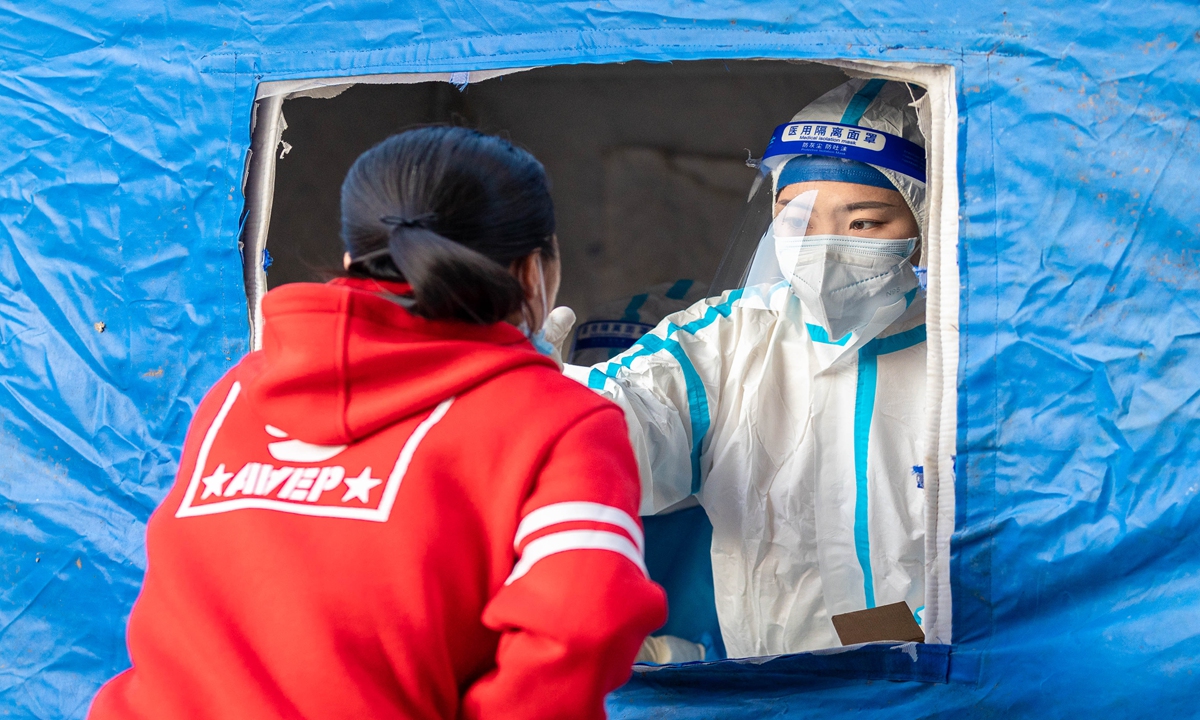
A resident receives nucleic acid testing in a residential community in Hohhot on Thursday. Photo: VCG
New Omicron variant BF.7 has swept to more provinces in China on Monday, less a week after it was firstly identified in Northwest China's Inner Mongolia Autonomous Region.
Shenzhen in South China's Guangdong Province became the latest region in the country to have detected the new variant on Tuesday. The local disease prevention and control center said most cases are infected with BF.7, BA.2.76 and BA.2.2, of which BF.7 was detected the first time in the city.
On Monday, officials from Yantai, a city in North China's Shandong Province, confirmed that locally-transmitted COVID-19 cases detected since October 4 were triggered by variant BF.7, which are highly homologous with those found in another province. One day earlier on Sunday, Shaoguan city in South China's Guangdong Province also detected cases of BF.7 variant.
The World Health Organization had warned against the fast-spreading BF.7 across the world, and has expected it to become the new dominate variant.
"Judging from the characteristics of BF.7, if decisive prevention measures were not adopted in time, there is high possibility that it could become the dominate variant in China as well," Yu Chuanhua, a professor specializing in epidemiology, told health-focused newspaper Jiankang Shibao on Sunday.
As a subvariant of Omicron BA.5, BF.7 has enhanced immunity evasion compared with BA.5, which means that it's still possible that people could be infected with BF.7 even if they have been infected before or have taken COVID-19 vaccines, Global Times learnt from medical experts.
But they said that the vaccines and oral antiviral pills used to treat COVID-19 are still effective toward BF.7, and the COVID-19 vaccines are effective at preventing severe cases and death from COVID-19.
The BF.7 had been reported spreading swiftly in Belgium, Germany, France and Denmark and England as early as September 23, according to media reports. Among cases in Belgium, the percentage of cases fueled by BF.7 has accounted 25 percent, while the percentage in Germany, France and Denmark were respectively around 10. While in the US, the new variant has ranked the top third dominant of all variants, accounting for 4.6 percent of all cases.
On September 28, Hohhot in Inner Mongolia Autonomous Region detected one local case. It's the first time that the new Omicron subvariant triggered a round of outbreak in Chinese mainland.
On Monday, Shenzhen reported 33 positive cases. All COVID-19 cases were detected in their early period of onset. The risk for a large-scale outbreak is low, the local CDC said.
Since October 4, the domestic flare-up triggered by BF.7 in Yantai has piled up to 10. They are mainly people who had travelled to other provinces and related cases. Wang Guiqiang, an official from local CDC in Yantai, told Monday's press briefing that with its strong transmission and contagiousness, the new variant could easily result to wide-scale infection, complicating epidemic control and prevention.
After infected with BF.7, patients generate symptoms including persistent cough, headache, chest pain, changes in sense of smell, hearing loss and shaking, similar to previous mutated variants of Omicron, Wang noted.
To address threats posed by BF.7, Yantai intensified anti-epidemic screen out on travelers who return from other cities and provinces. Those who come from other provinces will have to undergo nucleic acid test three times in five days and those from cities within the province to receive two tests in three days.
Shenzhen requires returnees from other cities to receive three tests in three days and during the period of testing, they are encouraged to stay at home.
Global Times




